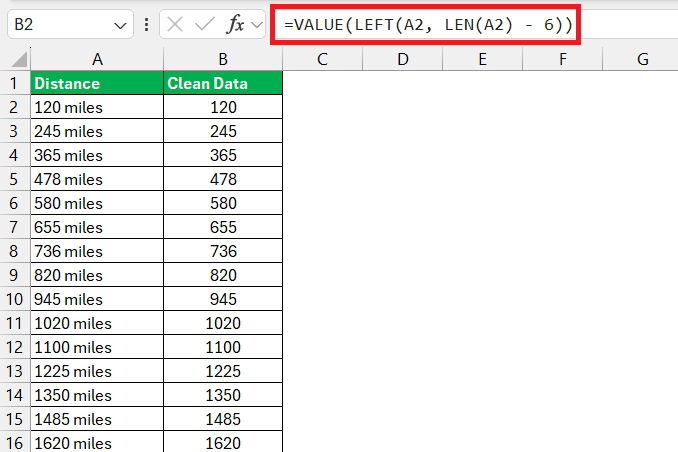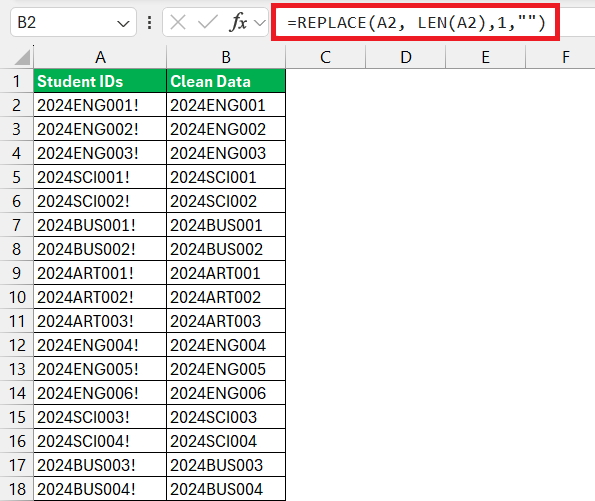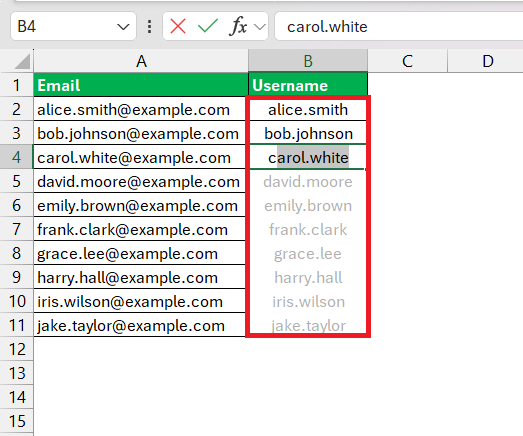In the realm of Microsoft Excel, mastering string manipulation is essential for effective data management. From large datasets to small spreadsheets, the ability to modify text strings is a key skill. Knowing how to remove last characters from strings, especially unwanted ones from strings, can greatly enhance data clarity and usefulness.
Key Takeaways:
- Versatile Functions: Excel’s LEFT and REPLACE functions are indispensable for removing unwanted characters from strings.
- Saving Time: Techniques like Flash Fill automate pattern recognition, speeding up data processing without complex formulas.
- Custom Solutions: Utilize VBA to create custom scripts for specific text manipulation tasks, offering precision and flexibility.
- Efficiency Boosters: Shortcut keys and a customized Quick Access Toolbar streamline workflow and improve efficiency in Excel.
Table of Contents
Introduction to Quick Excel Manipulations
The Importance of String Manipulation in Excel
In the world of Excel, string manipulation is a fundamental skill that can drastically improve your data management capabilities. Text data often comes with its own set of challenges, such as inconsistent formatting, extra spaces, or unwanted characters.
Whether you’re analyzing large datasets or simply streamlining small spreadsheets, knowing how to effectively manipulate strings is crucial. It impacts everything from sorting and searching to compiling reports and beyond. With the right skills, you’ll not only save time but also ensure that your data is clean, consistent, and primed for analysis.
Overview of Removing Characters from Strings
Removing characters from strings might seem like a minor action, but it’s one that holds significant weight when processing text data. Text formatting can often include additional characters that are either non-essential or downright erroneous. They might be leading, trailing, or in-between spaces, line breaks, or even custom text that you want to cleanse from your data.
When you need to extract just the meat of the data and leave the bones behind, that’s when character removal becomes invaluable. It’s a nifty trick that ranges from the simple act of tidying up data to complex operations like parsing out vital information from a string. By equipping yourself with a few handy techniques to cut out characters, you can ensure the text you’re working with is exactly how you need it to be – clean and uncluttered.
Basic Excel Functions for Character Removal
Employing the LEFT Function for Start Position Trimming
Imagine you have a string of text, but the only part you need is snugly sitting at the beginning. That’s when you ignite the power of the LEFT function. This function is perfect for surgical precision in text trimming, adeptly extracting characters from the starting point of your string.
To illustrate, let’s say you want to get rid of the word ” miles” from a distance value like “120 miles”. By utilizing the LEFT function in conjunction with the LEN function, you can determine the number of characters to keep. The formula =VALUE(LEFT(A2, LEN(A2) - 6)) calculates the total length of the text in A2, subtracts the length of the unwanted ” miles”, and extracts just the number “120”.
This technique is especially useful when your text strings have a consistent ending you wish to eliminate. By customizing the number to subtract in the formula, the LEFT function can cater to various scenarios, ensuring you’re left with the precise data you need, nothing more, nothing less.
Using the REPLACE Function to Remove Last Characters
To trim the last character from a text string in Excel, similar to using the RIGHT function, you can employ the REPLACE function as a versatile alternative. This function allows you to specify exactly which parts of a string to replace and with what, making it particularly useful for manipulating text data such as Student IDs.
For instance, consider you have a Student ID in cell B5 that includes an unwanted last character. You want to remove this character without affecting the rest of the ID. The REPLACE function can be employed to achieve this efficiently.
To remove the last character from the Student ID in cell B5 using the REPLACE function, the formula would be:=REPLACE(A2, LEN(A2),1,"")
This method is straightforward and ensures precise manipulation of text strings. By adjusting the parameters, you can remove characters from any position in your strings, not just the end. Just like handling text with precision, it’s important to input the correct parameters to ensure you modify exactly what you intend and avoid unintended text alterations.
Advanced Techniques and Shortcuts
Streamlining Processes with Flash Fill
Even in a sea of functions and formulas, Excel offers another lifeboat with its Flash Fill feature—a real time-saver when it comes to text manipulation. It’s like an intuitive assistant that recognizes your pattern after just one or two examples and replicates it automatically across your data.
Say you have a list of email addresses and you want to extract only usernames without the domain. You’d type the first username correctly in an adjacent cell and as soon as you start typing the next one, Flash Fill leaps into action. It gives you a sneak peek of what the rest of the column will look like, based on your pattern. Hit Enter, and voilà, your column is populated with just the data you need, comma and domain-free.
The beauty of Flash Fill lies in its simplicity and power to understand patterns without complex formulas. It’s about efficiency—reducing what could have been several clicks and keystrokes into just a couple. Plus, it’s adaptable, working with numbers, dates, and text strings seamlessly.
Harnessing VBA for Custom Removal Tasks
When your data manipulation needs outgrow the built-in Excel functions, Visual Basic for Applications (VBA) steps in as your custom toolmaker. Creating a VBA macro may sound daunting, but it’s like crafting a tailor-made robot that performs exactly as you need, especially for repetitive tasks like removing the last character from strings.
For instance, with a bit of VBA code, you can design a subroutine to iterate through a range of cells and trim the last character off each one. The code would look something like this presentation:
Sub RemoveLastCharacter()</div> <div class="ql-code-block" data-language="plain">Dim rng As Range</div> <div class="ql-code-block" data-language="plain">Dim cell As Range</div> <div class="ql-code-block" data-language="plain">Set rng = Selection</div> <div class="ql-code-block" data-language="plain">For Each cell In rng</div> <div class="ql-code-block" data-language="plain">If Len(cell.Value) > 0 Then</div> <div class="ql-code-block" data-language="plain">cell.Value = Left(cell.Value, Len(cell.Value) - 1)</div> <div class="ql-code-block" data-language="plain">End If</div> <div class="ql-code-block" data-language="plain">Next cell</div> <div class="ql-code-block" data-language="plain">End Sub
This script navigates cell by cell, checking for content and trimming it down by one character. The beauty of VBA is its flexibility; you can modify the script to remove any number of characters, from the beginning or the end, or even target specific characters within the string.
A custom VBA function ups your Excel game, enabling you to perform complex operations with just a single function call. However, remember that a macro-enabled worksheet (.xlsm) is necessary to store and run your VBA code, ensuring that your custom tools are always at hand.
The creation of such a solution is a blend of coding and Excel knowledge—worth the investment for time saved in the future.
Tips and Tricks for Maximum Efficiency
Shortcut Keys and Quick Access Toolbar Customization
Picture this: you’re working in Excel and speed is of the essence. You’re copying, pasting, calculating, and formatting at the speed of light. This is where shortcut keys and a well-customized Quick Access Toolbar (QAT) can make all the difference. They are your shortcuts to efficiency, helping you perform actions quickly without having to navigate through the tabs and menus.
Memorize a handful of shortcut keys, and you’ll be navigating through cells and formulas with impressive agility. For instance, the ever-popular Ctrl + C and Ctrl + V for copy and paste, or Ctrl + Z for the sweet relief of undoing a mistake. There’s a shortcut for just about everything, and the more you use them, the faster your workflow.
Customizing the Quick Access Toolbar is like setting up your personal toolbox—you place the tools you use the most up where you can grab them without a second thought. Whether it’s the Trim function, Flash Fill, or perhaps a VBA script you’ve written, having these tools at the ready can turn repetitive processes into a one-click event.
By tailoring these features to suit your own workflow, you become the conductor of your Excel symphony, orchestrating data management with precision and speed.
FAQs
What is the quickest way to remove the last character from a cell in Excel?
The quickest way to remove the last character from a cell in Excel is to use the LEFT and LEN functions together in a formula like this: =LEFT(A1, LEN(A1) - 1). Simply replace A1 with the cell address you’re working with, and this will trim the last character from the string in that cell.
Can I remove the last character from multiple cells at once?
Yes, you can remove the last character from multiple cells at once in Excel by filling down the formula =LEFT(A1, LEN(A1) - 1). Apply it to the first cell, then drag the fill handle over the range you want to adjust, and Excel will process all the selected cells simultaneously.
Is it possible to undo the removal if I make a mistake?
Absolutely, if you make a mistake while removing the last character, simply press Ctrl+Z to undo the last action. If you’ve made a series of actions, use the Undo icon in the Quick Access Toolbar, where you can reverse up to 100 steps.
How do I remove the last character of a string?
To remove the last character of a string in Excel, use the formula =LEFT(A1, LEN(A1) - 1) in a new cell, replacing A1 with the reference to your string-containing cell. This trims the last character from the end of the string.
What is the formula to remove the last 5 characters in Excel?
The formula to remove the last 5 characters in a string in Excel is =LEFT(A1, LEN(A1) - 5), where A1 is the cell with the original string. This will give you the string without the last 5 characters.
John Michaloudis is a former accountant and finance analyst at General Electric, a Microsoft MVP since 2020, an Amazon #1 bestselling author of 4 Microsoft Excel books and teacher of Microsoft Excel & Office over at his flagship MyExcelOnline Academy Online Course.










